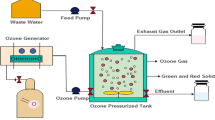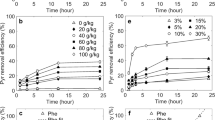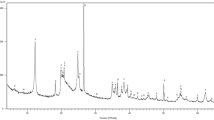Abstract
Creosote is a complex mixture containing mainly polycyclic aromatic hydrocarbons (PAHs). The remediation of creosote-contaminated sites becomes a challenge due to the numerous compounds and the specific soil properties. Treatability tests using advanced homogeneous (HM system) and heterogeneous (HT system) oxidative processes were applied with sandy soil artificially contaminated with creosote. The creosote was collected in a contaminated site in the state of São Paulo, Brazil. Sodium persulfate (SP) was the reaction oxidizing agent used. For the HM system, SP was activated by ferrous ions (Fe2+) chelated by citric acid (C6H8O7) and in the HT system, clay-based iron catalyst (CAT) was used for the SP activation. These two methods can be applied for in situ processes, without generating waste and effluents that need further treatment. Experimental designs were applied to determine the appropriate reagent concentrations to provide better removal efficiency for the total of 9 selected PAHs. As far as we know, this is the first study comparing homogeneous and heterogeneous systems while applying CAT to remediate PAH-contaminated soils. The results indicated that the HT system was more efficient than the HM system, with PAH removal of 97% and 61%, respectively. The treatability tests performed provide an efficient application of in situ chemical oxidation (ISCO) in tropical regions, such as Brazil, for the remediation of areas contaminated by PAHs.

Similar content being viewed by others
Availability of Data and Material
Not applicable.
Code Availability
Not applicable.
References
Adityosulindro, S., Julcour, C., & Barthe, L. (2018). Heterogeneous Fenton oxidation using Fe-ZSM5 catalyst for removal of ibuprofen in wastewater. Journal of Environmental Chemical Engineering. https://doi.org/10.1016/j.jece.2018.09.007
Aranha, R. M., Magalhães, V. M. A., Mendes, G. P., Soares, L. C. R., Barbosa, A. M., Nascimento, C. A. O., Vianna, M. M. G. R., & Chiavone-Filho, O. (2020). Characterization and partitioning behavior of creosote in different matrices: Soil, water and air. Water, Air, & Soil Pollution. https://doi.org/10.1007/s11270-020-04772-y
Bastidas, K. G., Sierra, C. A., & Ramirez, H. R. Z. (2018). Heterogeneous Fenton oxidation of Orange II using iron nanoparticles supported on natural and functionalized fique fiber. Journal of Environmental Chemical Engineering. https://doi.org/10.1016/j.jece.2018.06.001
Bel Hadjltaief, H., Costa, P., Beaunier, P., Gálvez, M. E., & Ben Zina, M. (2014). Fe-clay-plate as a heterogeneous catalyst in photo-Fenton oxidation of phenol as probe molecule for water treatment. Applied Clay Science. https://doi.org/10.1016/j.clay.2014.01.02
Bendouz, M., Dionne, J., Tran, L. H., Coudert, L., Mercier, G., & Blaiz, J. F. (2017). Polycyclic aromatic hydrocarbon oxidation from concentrates issued from an attrition process of polluted soil using the Fenton reagent and permanganate. Water, Air, & Soil Pollution. https://doi.org/10.1007/s11270-017-3292-x
Cargouët, M., Jeannee, N., Vidart, B., & Gregori, P. (2018). Polycyclic aromatic hydrocarbon (PAH) levels in environmental media potentially impacted by reused or stored creosote-treated railway ties. Environmental Science and Pollution Research 25.https://doi.org/10.1007/s11356-018-1910-9
CETESB, (2016). Valores Orientadores para Solos e Águas Subterrâneas no Estado de São Paulo. São Paulo, Brasil. Retrieved April 28, 2021, from https://cetesb.sp.gov.br/aguas-subterraneas/wp-content/uploads/sites/13/2013/11/tabela_vos_2016_site.pdf
CETESB, (2019). Relatório de áreas contaminadas e reabilitadas no Estado de São Paulo. Companhia Ambiental do Estado de São Paulo, Brasil. Retrieved April 23, 2021, from https://cetesb.sp.gov.br/areas-contaminadas/wp-content/uploads/sites/17/2020/02/TEXTO-EXPLICATIVO-2019-12.02.20.pdf.
Coll, F. R., & Paschl, K. P. (2013). Creosote DNAPL recovery-well design for mass removal. Remediation Journal. https://doi.org/10.1002/rem.21346
Duan, L., Naidu, R., Thavamani, P., Meaklim, J., & Megharaj, M. (2015). Managing long-term polycyclic aromatic hydrocarbon contaminated soils: A risk-based approach. Environmental Science and Pollution Research. https://doi.org/10.1007/s11356-013-2270-0
EMBRAPA - Centro Nacional de Pesquisa de Solos. (2017). Manual de Métodos de Análise de Solo. 3 Ed. Centro Nacional de Pesquisa de Solos. Empresa Brasileira de Pesquisa Agropecuária Rio de Janeiro, Brasil.
FEAM (2019) Inventário de áreas contaminadas de minas gerais. Fundação Estadual do Meio Ambiente. Belo Horizonte, Brasil. Retrieved April 23, 2021, from http://www.feam.br/images/stories/2019/GEST%C3%83O_AREAS_CONTAMINADAS/Invent%C3%A1rio_de_%C3%A1reas_contaminadas_2019.pdf
Forsey, S. (2004). In situ chemical oxidation of creosote/coal tar residuals: Experimental and numerical investigation. UW Space. Retrieved April 28, 2021, from http://hdl.handle.net/10012/1275
Gao, Y., Zhang, Z., Li, S., Liu, J., Yao, L., Li, Y., & Zhang, H. (2016). Insights into the mechanism of heterogeneous activation of persulfate with a clay/iron-based catalyst under visible LED light irradiation. Applied Catalysis b: Environmental. https://doi.org/10.1016/j.apcatb.2015.12.002
INEA. (2015). Cadastro de áreas contaminadas no Estado do Rio de Janeiro - 3ª edição. Instituto Estadual do Ambiente. Rio de Janeiro, Brasil. Retrieved April 23, 2021, from http://www.inea.rj.gov.br/Portal/Agendas/LicenciamentoAmbiental/Licenciamento-saiba-mais/GestaodeRiscoAmbientalTec/AvaliacaodeAreasContaminadas/index.htm
Isosaari, P., Piskonen, R., Ojala, P., Voipio, S., Eilola, K., Lehmus, E., & Itävaara, M. (2007). Integration of electrokinetics and chemical oxidation for the remediation of creosote-contaminated clay. Journal of Hazardous Materials. https://doi.org/10.1016/j.jhazmat.2006.10.068
Itthipoonthanakorn, T., Dann, S. E., Crout, N. M. J., & Shaw, G. (2019). Nuclear weapons fallout 137Cs in temperate and tropical pine forest soils, 50 years post-deposition. Science of the Total Environment. https://doi.org/10.1016/j.scitotenv.2019.01.073
Killian, P. F., Bruell, C. J., Liang, C., & Marley, M. C. (2007). Iron (II) activated persulfate oxidation of MGP contaminated soil. Soil & Sediment Contamination. https://doi.org/10.1080/15320380701623206
Kueper, B. H., Lerner, D. N., Wealthall, G. P., Smith, J. W. N., & Leharne, S. A. (2003). An illustrated handbook of DNAPL transport and fate in the subsurface. Research Report. Environment Agency, Bristol, UK.
Kulik, N., Goi, A., Trapido, M., & Tuhkanen, T. (2006). Degradation of polycyclic aromatic hydrocarbons by combined chemical pre-oxidation and bioremediation in creosote contaminated soil. Journal of Environmental Management. https://doi.org/10.1016/j.jenvman.2005.05.005
Lemaire, J., Buès, M., Kabeche, T., Hanna, K., & Simonnot, M. O. (2013). Oxidant selection to treat an aged PAH contaminated soil by in situ chemical oxidation. Journal of Environmental Chemical Engineering. https://doi.org/10.1016/j.jece.2013.09.018
Liang, C., Bruell, C. J., Marley, M. C., & Sperry, K. L. (2004). Persulfate oxidation for in situ remediation of TCE. II. Activated by chelated ferrous ion. Chemosphere. https://doi.org/10.1016/j.chemosphere.2004.01.030
Liang, C., Wang, Z. S., & Mohanty, N. (2006). Influences of carbonate and chloride ions on persulfate oxidation of trichloroethylene at 20 °C. Science of the Total Environment. https://doi.org/10.1016/j.scitotenv.2006.08.028
Luthy, R. G., Aiken, G. R., Brusseau, M. L., Cunningham, S. D., Gschwend, P. M., Pignatello, J. J., Reinhard, M., Traina, S. J., Weber, W. J., & Westall, J. C. (1997). Sequestration of hydrophobic organic contaminants by geosorbents. Environmental Science and Technology. https://doi.org/10.1021/es970512m
Magalhães, V. M. A., Mendes, G. P., Costa-Filho, J. D. B., Cohen, R., Partiti, C. S., Vianna, M. M., & Chiavone-Filho, O. (2020). Clay-based catalyst synthesized for chemical oxidation of phenanthrene contaminated soil using hydrogen peroxide and persulfate. Journal of Environmental Chemical Engineering.https://doi.org/10.1016/j.jece.2019.103568
Matzek, L. W., & Carter, K. E. (2018). Activated persulfate for organic chemical degradation: A review. Chemosphere. https://doi.org/10.1016/j.chemosphere.2016.02.055
Mendes, G. P., Magalhães, V. M. A., Soares, L. C. R., Aranha, R. M., Nascimento, C. A. O., Vianna, M. M. G. R., & Chiavone-Filho, O. (2020). Treatability studies of naphthalene in soil, water and air with persulfate activated by iron(II). Journal of Environmental Sciences. https://doi.org/10.1016/j.jes.2019.11.015
Oliveira, F. C., Freitas, J. G., Furquim, S. A. C., Rollo, R. M., Thomnson, N. R., Alleoni, L. R. F., & Nascimento, C. A. O. (2016). Persulfate interaction with tropical soils. Water, Air, & Soil Pollution. https://doi.org/10.1007/s11270-016-3000-2
Payne, T. E., & Edis, R. (2012). Chapter 3 - Mobility of radionuclides in tropical soils and groundwater, Editor(s): John R. Twining, Radioactivity in the environment, Elsevier, Volume 18. Pages 93–120, ISSN 1569–4860, ISBN 9780080450162. https://doi.org/10.1016/B978-0-08-045016-2.00003-5.
Peluffo, M., Pardo, F., Santos, A., & Romero, A. (2016). Use of different kinds of persulfate activation with iron for the remediation of a PAH-contaminated soil. Science of the Total Environment. https://doi.org/10.1016/j.scitotenv.2015.09.034
Pham, A. L. T., Lee, C., Doyle, F. M., & Sedlak, D. L. (2009). A silica-supported iron oxide catalyst capable of activating hydrogen peroxide at neutral pH values. Environmental Science and Technology. https://doi.org/10.1021/es902296k
Pham, A. L., Doyle, F. M., & Sedlak, D. L. (2012). Inhibitory effect of dissolved silica on H2O2 decomposition by iron(III) and manganese(IV) oxides: Implications for H2O2 -based in situ chemical oxidation. Environmental Science & Technology. https://doi.org/10.1021/es203612d
Pouran, S. R., Raman, A. A. A., & Daud, W. M. A. (2014). Review on the application of modified iron oxides as heterogeneous catalysts in Fenton reactions. Journal of Cleaner Production. https://doi.org/10.1016/j.jclepro.2013.09.013
Pu, M., Ma, Y., Wan, J., Wang, Y., Wang, J., & Brusseau, M. L. (2017). Activation performance and mechanism of a novel heterogeneous persulfate catalyst: Metal-organic framework MIL-53(Fe) with FeII/FeIII mixed-valence coordinatively unsaturated iron center. Catalysis Science and Technology. https://doi.org/10.1039/C6CY02355J
Pulicharla, R., Drouinaud, R., Brar, S. K., Drogui, P., Proulx, F., Verma, M., & Surampalli, R. Y. (2018). Activation of persulfate by homogeneous and heterogeneous iron catalyst to degrade chlortetracycline in aqueous solution. Chemosphere. https://doi.org/10.1016/j.chemosphere.2018.05.134
Ranc, B., Faure, P., Croze, V., & Simonnot, M. O. (2016). Selection of oxidant doses for in situ chemical oxidation of soils contaminated by polycyclic aromatic hydrocarbons (PAHs): A review. Journal of Hazardous Materials. https://doi.org/10.1016/j.jhazmat.2016.03.068
Rivas, F. J. (2006). Polycyclic aromatic hydrocarbons sorbed on soils: A short review of chemical oxidation based treatments. Journal of Hazardous Materials. https://doi.org/10.1016/j.jhazmat.2006.07.048
Silva-Rackov, C. K. O., Aguiar, L. G., Souza, A. R., Silva, S. S. O., Câmara, A. G., Vianna, M. M. G. R., Foletto, E. L. F., Nascimento, C. A. O., & Chiavone-Filho, O. (2017). Remediation of phenanthrene-contaminated soil by persulfate activated with Fe-modified diatomite: Kinetic and statistical approaches. Water, Air, & Soil Pollution. https://doi.org/10.1007/s11270-017-3456-8
Simarro, R., González, N., Bautista, L. F., Sanz, R., & Molina, M. C. (2011). Optimisation of key abiotic factors of PAH (naphthalene, phenanthrene and anthracene) biodegradation process by a bacterial consortium. Water, Air, & Soil Pollution. https://doi.org/10.1007/s11270-010-0593-8
Tsitonaki, A., Petri, B., Crimi, M., Mosbæk, H., Siegrist, R. L., & Bjerg, P. L. (2010). In situ chemical oxidation of contaminated soil and groundwater using persulfate: A review. Critical Reviews in Environmental Science and Technology. https://doi.org/10.1080/10643380802039303
US EPA - United States Environmental Protection Agency. (1996). Method 3510C - Separatory funnel liquid-liquid extraction. Retrieved May 15, 2021, from https://www.epa.gov/sites/production/files/2015-12/documents/3510c.pdf
US EPA - United States Environmental Protection Agency. (2019). Regional Screening Level (RSL) Summary Table (TR=1E-06, HQ=1). Retrieved May 16, 2021, from https://semspub.epa.gov/work/HQ/199628.pdf
US EPA- United States Environmental Protection Agency. (2007). Method 3550C - Ultrasonic extraction. Retrieved March 25, 2021, from https://www.epa.gov/sites/production/files/2015-12/documents/3550c.pdf. Accessed 22 May 2021
US EPA - United States Environmental Protection Agency. (2020). Superfund Remedy Report. 16th Edition. Retrieved March 25, 2021, from https://www.epa.gov/sites/production/files/2020-07/documents/100002509.pdf
USDA - United States Department of Agriculture. Soil Survey Division Staff. (1993). Clarification of soil texture class boundaries. Retrieved March 05, 2021, from https://www.nrcs.usda.gov/Internet/FSE_DOCUMENTS/nrcs142p2_031477.pdf
Usman, M., Faure, P., Hanna, K., Abdelmoula, M., & Ruby, C. (2012). Application of magnetite catalyzed chemical oxidation (Fenton-like and persulfate) for the remediation of oil hydrocarbon contamination. Fuel. https://doi.org/10.1016/j.fuel.2012.01.017
Valderrama, C., Alessandri, R., Aunola, T., Cortina, J. L., Gamisans, X., & Tuhkanen, T. (2009). Oxidation by Fenton’s reagent combined with biological treatment applied to a creosote-comtaminated soil. Journal of Hazardous Materials. https://doi.org/10.1016/j.jhazmat.2008.11.108
Wang, Y., Zhang, W., Fan, R., Sheng, G., & Fu, J. (2014). Biological monitoring of environmental exposure to polycyclic aromatic hydrocarbons in subjects living in the area of recycling electronic garbage, in Southern China. Environmental Science and Pollution Research. https://doi.org/10.1007/s11356-014-2869-9
Wei, X., Wu, H., & Sun, F. (2017). Magnetite/Fe-Al-montmorillonite as a Fenton catalyst with efficient degradation of phenol. Journal of Colloid and Interface Science. https://doi.org/10.1016/j.jcis.2017.05.110
Yan, D. Y. S., & Lo, I. M. C. (2013). Removal effectiveness and mechanisms of naphthalene and heavy metals from artificially contaminated soil by iron chelate-activated persulfate. Environmental Pollution. https://doi.org/10.1016/j.envpol.2013.02.030
Yen, C., Chen, K., Kao, C., Liang, S., & Chen, T. (2011). Application of persulfate to remediate petroleum hydrocarbon-contaminated soil: Feasibility and comparison with common oxidants. Journal of Hazardous Materials. https://doi.org/10.1016/j.jhazmat.2010.12.129
Zeng, Q., Dong, H., Wang, X., Yu, T., & Cui, W. (2017). Degradation of 1, 4-dioxane by hydroxyl radicals produced from clay minerals. Journal of Hazardous Materials. https://doi.org/10.1016/j.jhazmat.2017.01.040
Zhao, D., Liao, X., Yan, X., Hulling, S. G., Chai, T., & Tao, H. (2013). Effect and mechanism of persulfate activated by different methods for PAHs removal in soil. Journal of Hazardous Materials. https://doi.org/10.1016/j.jhazmat.2013.03.056
Zhou, Z., Liu, X., Sun, K., Lin, C., Ma, J., He, M., & Ouyang, W. (2019). Persulfate-based advanced oxidation processes (AOPs) for organic-contaminated soil remediation: A review. Chemical Engineering Journal. https://doi.org/10.1016/j.cej.2019.04.213
Acknowledgements
The authors would like to express their gratitude to the Coordenação de Aperfeiçoamento de Pessoal de Nível Superior (CAPES – Project PROCAD No. 88887.124192/2014-00) and to the Technological Research Institute (IPT) and its foundation (FIPT), through the Novos Talentos Program.
Funding
This research was supported by the National Council for Scientific and Technological Development (CNPq), the Coordination for the Improvement of Higher Education Personnel (CAPES – Project PROCAD-CAPES No. 88881.068433/2014–01) and the Technological Research Institute (IPT) and its foundation (FIPT), through the Novos Talentos Program.
Author information
Authors and Affiliations
Corresponding author
Ethics declarations
Ethics Approval
Not applicable.
Consent to Participate
All authors agree to participate in this publication.
Consent for Publication
All authors agree with the publication.
Conflict of Interest
The authors declare no competing interests.
Additional information
Publisher's Note
Springer Nature remains neutral with regard to jurisdictional claims in published maps and institutional affiliations.
Rights and permissions
About this article
Cite this article
Magalhães, V.M.A., Aranha, R.M., Mendes, G.P. et al. Homogeneous and Heterogeneous Advanced Oxidation Processes: Treatability Studies on Artificially Contaminated Soils with Creosote. Water Air Soil Pollut 233, 29 (2022). https://doi.org/10.1007/s11270-022-05498-9
Received:
Accepted:
Published:
DOI: https://doi.org/10.1007/s11270-022-05498-9




